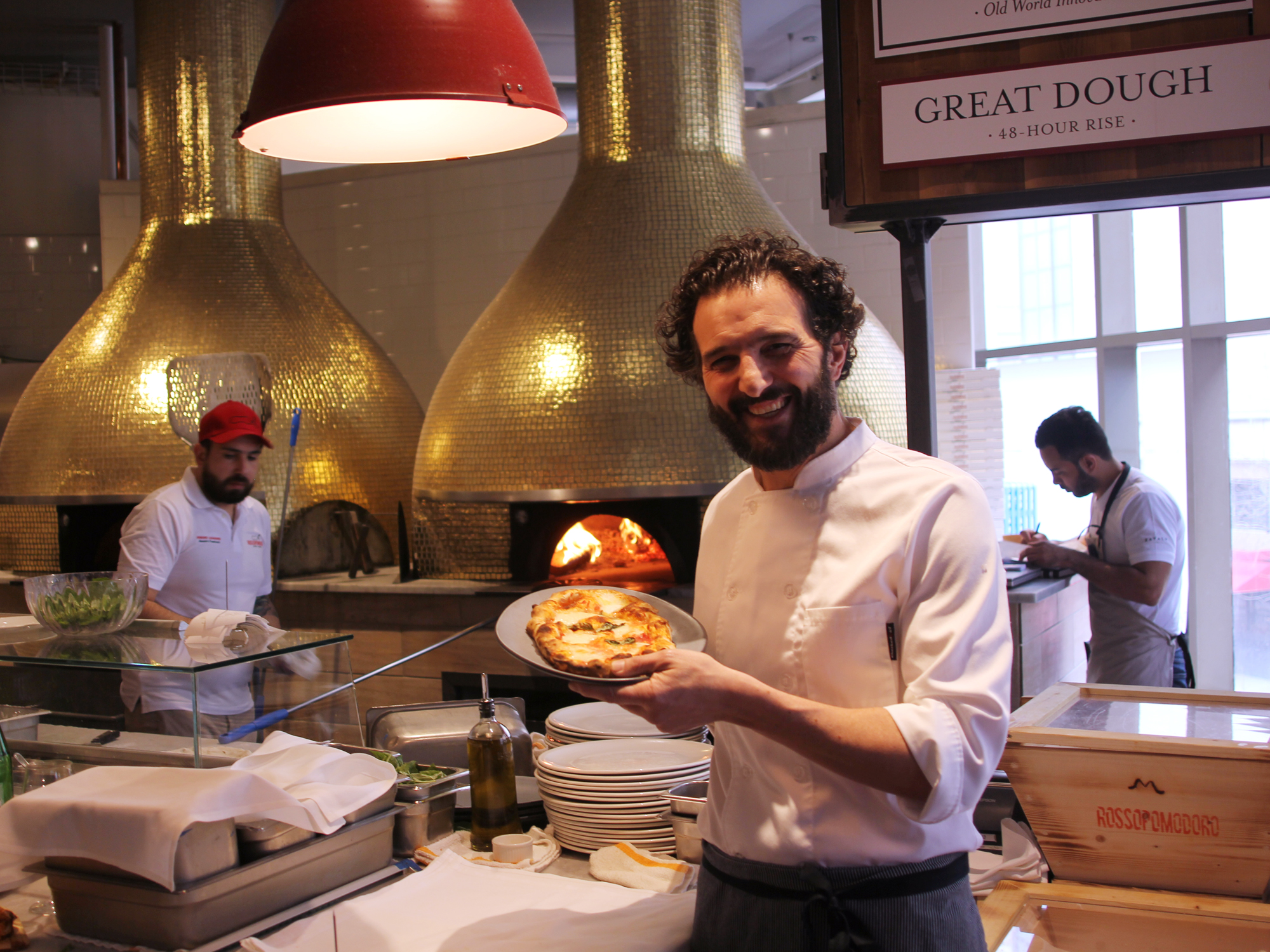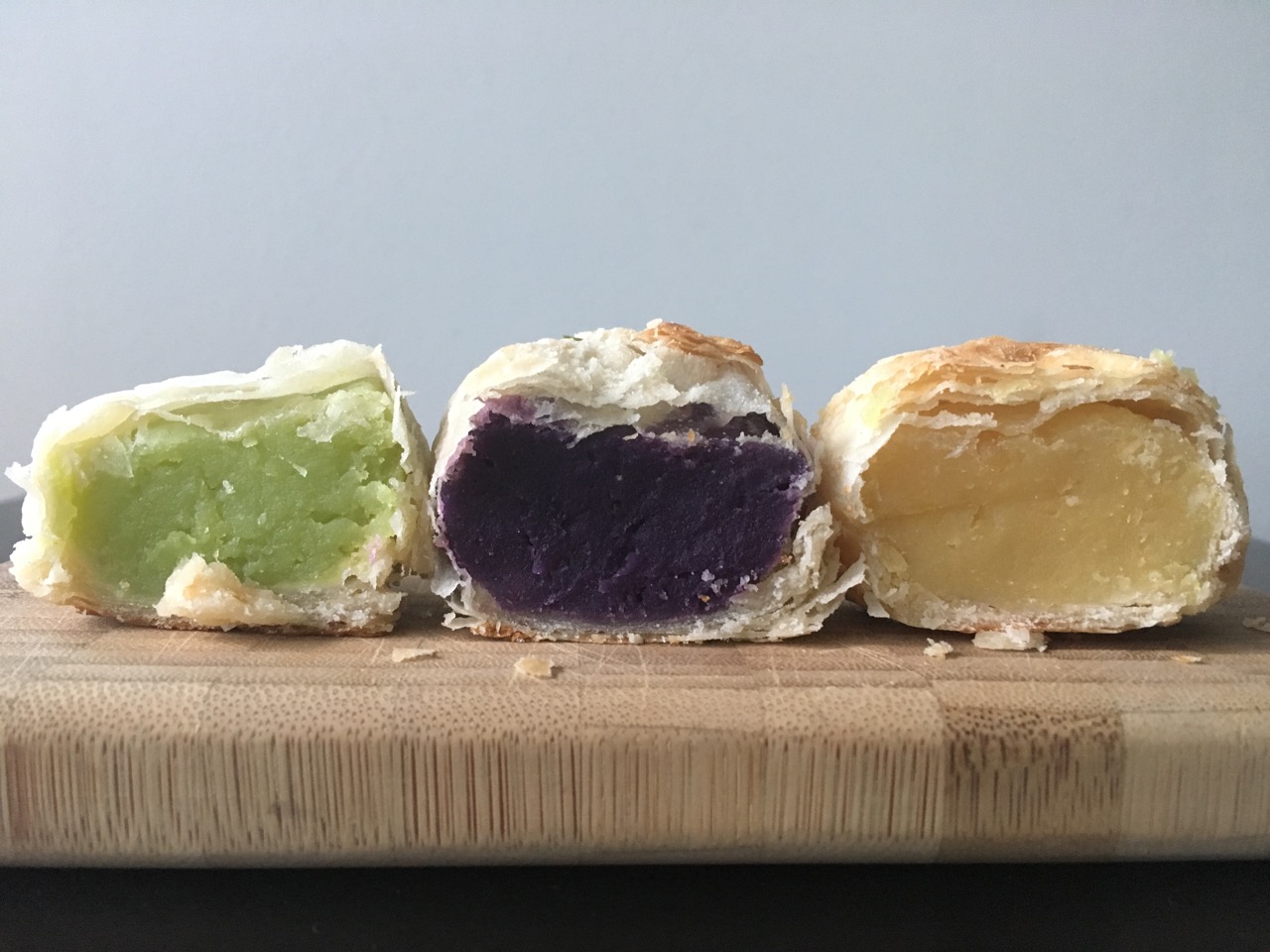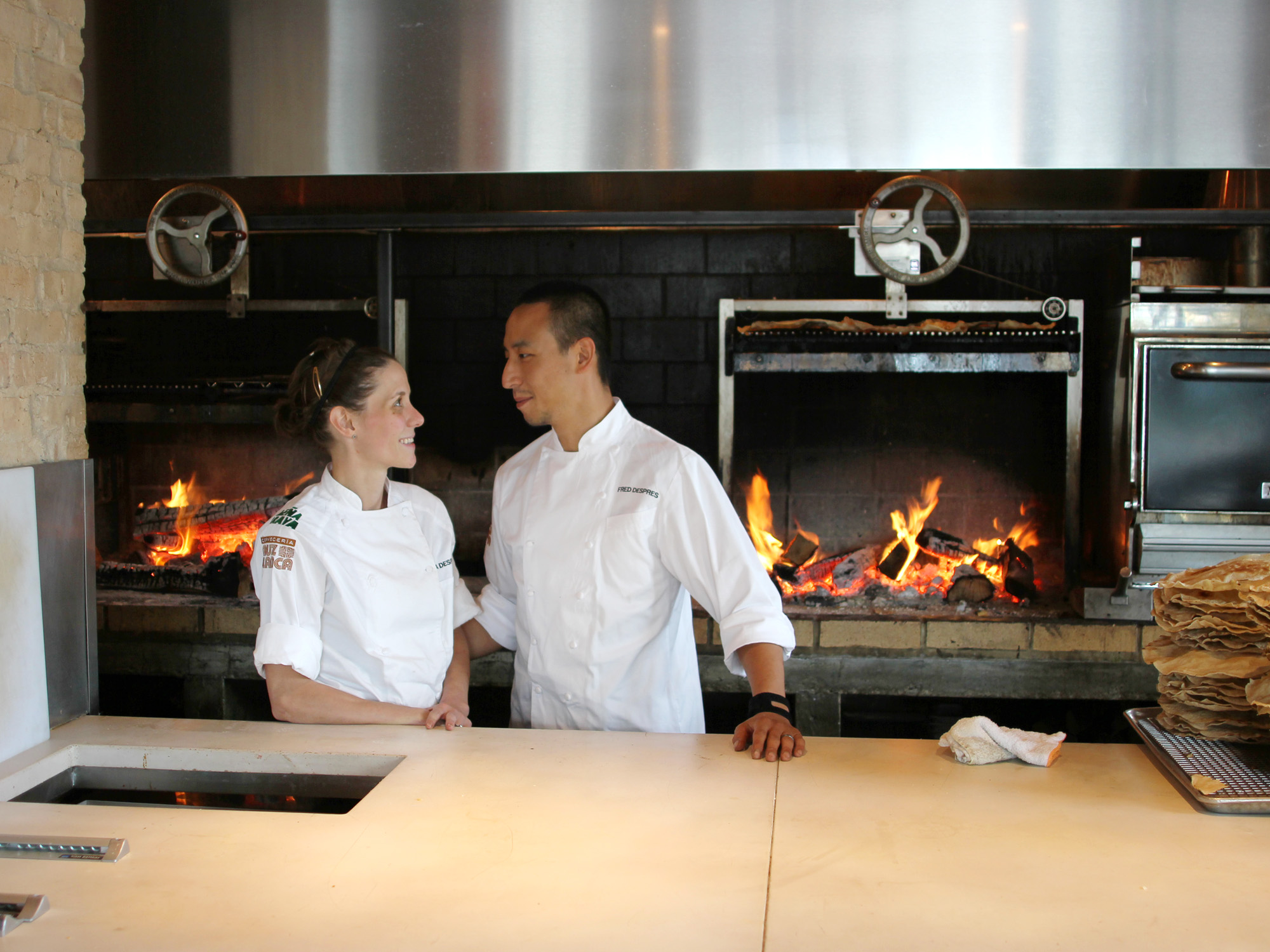IT WAS LOVE AT FIRST SIGHT for me—with Frontera Grill’s book collection, which I first saw when I was invited to be on The Feed podcast with Rick Bayless and Steve Dolinsky, recorded in the meeting room/library/test kitchen inside the warren of offices above Bayless’s restaurants on Clark Street.
A few thousand books, two big walls of English-language books, on everything from barbecue to wine, and then another large bookcase of Spanish-language ones—including a foot or two of rare 19th century Mexican cookbooks, bound in plain yellowed paper, like something you’d see on the shelf of a Jesuit padre. All free to be borrowed by any employee who wants to know more about the food they make.
It’s a reminder that Frontera and everything else that has sprung from it (TV shows and podcasts, supermarket brands, Leña Brava/Cruz Blanca, being able to eat at the airport) is rooted not only in a well-run restaurant empire, but in what began as an anthropology student’s study of Mexican food and Mexico.
Born to a restaurant family in Oklahoma, Rick Bayless was a grad student working as a cook to put himself through school, before he was ever a chef who approached creating a menu like an anthropologist. And before he and his wife Deann ever opened this first restaurant 30 years ago, they spent years working in Mexico on a book—Authentic Mexican, the first of a short shelf of Bayless-authored cookbooks.
Frontera Grill’s 30th anniversary will be marked with a fancy fundraiser party on April 30, benefiting the Frontera Farmer Foundation and FamilyFarmed. Recounting Frontera’s story, we wound up pushing it beyond its opening in late March of 1987, into the prehistory of a young couple trying to understand Mexico’s food culture (one plate at a time, you might say). Besides Rick and Deann Bayless, this oral history included Richard James, an African-American cook who started as a line cook 20 years ago and would eventually become chef de cuisine at Frontera.
Here’s the winding and often unexpected tale of a restaurant that has helped pioneer the chef-owned restaurant in Chicago, buying local food, cooking farm to table, taking ethnic cuisines as seriously as fine dining, the River North boom—in short, a restaurant that has mattered as much as any restaurant in Chicago, and to no small degree America, over the past three decades.
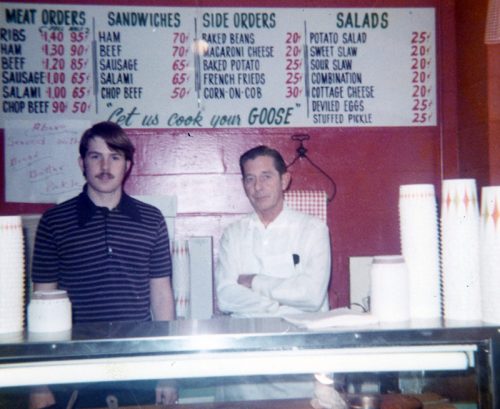
Bayless Jr. and Sr. at the family restaurant, The Hickory House
1. Tex-Mex Beginnings
FOODITOR: Let’s go back to the beginning. Rick, you grew up in Oklahoma; I grew up in Kansas, so I think I probably have a pretty good idea of what kind of Mexican food existed when you were growing up.
RICK BAYLESS: I think Oklahoma, because it’s closer to Texas, we had a whole bunch of Texas chains in our area. But there was one that was Oklahoma City-owned called El Charrito. They had three of them in the city and that’s what I grew up on. It was really classic Tex-Mex food—Central Texas food is what I would call it.
Guacamole was never a dip, that came later, guacamole was a salad. And it always came on a lettuce leaf. You could get the combination plate, which had an enchilada, which is what I always loved, and a hard shell taco on it. Although at this place it wasn’t really the U-shaped hard shell tacos like you could buy in the grocery store—they were actually tacos that were folded and they had a toothpick through them and they were fried. So it was a little more homestyle. And you could get tamales. And that’s kind of it, for what I remember—the menus were really tiny, they didn’t have much on them.
Of course, I grew up in the days before fajitas were a popular thing, or chimichangas, none of that. That came when I was in the last of high school and the Chi-Chi’s chain came to Oklahoma City and popularized the chimichanga. But I had gone to Mexico when I was 14, and that’s where I was really introduced to the food of Mexico, which doesn’t really bear that much resemblance to that Tex-Mex food.
So you’d already been to Mexico before you started researching it?
I had been to Mexico several times, during high school. I started when I was 14 and I went back every year, pretty much, until I got to college, and my undergrad degree is in Spanish language, literature and Latin American studies.
After that I went to graduate school in anthropology and linguistics. I was really interested in the relationship between language and culture, how a culture is expressed uniquely in the language. Or the dialect—like the Spanish of Mexico is different from the Spanish of Spain. And how the Spanish of Mexico reflects who the people of Mexico are. So I was really interested in that.
But I’d always cooked, so when I got to Ann Arbor for graduate school, I had jobs cooking all the time. And I got really interested in teaching cooking and writing about cooking during that time, and I eventually opened a small catering company with a friend of mine.
Then when I was finished with all my graduate stuff, I’d passed my prelims for my Ph.D and I was starting to work on my dissertation, I got super into food. And I was spending most of my time just doing food stuff. So I decided to take a year off from my dissertation work and just explore food and… I never went back.
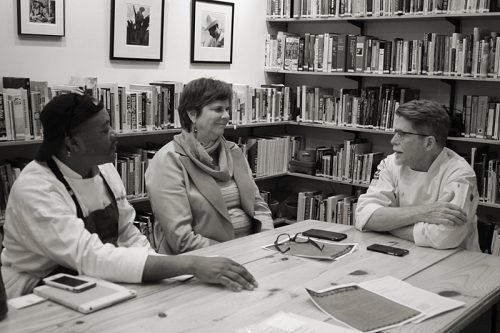
I just decided that food was going to be my thing. So I was really interested in the relationship between food and culture. At the beginning I really wasn’t focusing on Mexico. But that sort of came back to me as I realized I had all this background in Mexico, and I had spent a lot of time there, and I spoke the language and I would be able to really research it. And so I began to do a lot of my teaching and writing and thinking and cooking in Mexican food.
But you also started doing food TV in the late 70s, before you were really a chef, at least with a restaurant. How did that happen?
That was a quirk of fate. There was a PBS television station in Bowling Green, Ohio, at the university there, and they were interested in doing a show—there’s a lot of migrant workers that had settled in that area there. And they had found this really vivacious woman who had moved there as a migrant worker, and then she’d become known as this really excellent cook in the community. And they were going to do a PBS show with her just for the local community. Just sort of a way of saying, these are our neighbors here, here’s what they cook.
And at the last moment, she sort of pulled out. And they put an ad in the paper in Toledo at that point, looking for a host for a cooking show. And some friends of mine who had been taking my cooking classes sent me the contact information, I contacted them, and we did two seasons of that show [Cooking Mexican].
I took all the money I made off of doing that, and invested it in going back to Mexico and just doing research trips so I could deepen my knowledge. And that’s how I got the bug.
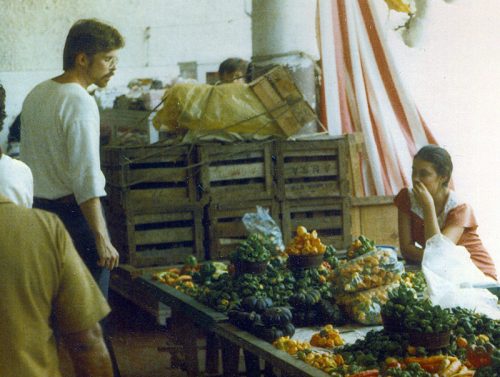
Shopping at a Mexican market
2. Eating Research
RICK: I had done some restaurant consulting after that, and these people in Cleveland asked me, would I consult on a project. So I helped them with their menu development, and as happens often, the chef they hired that I trained just couldn’t do it and he departed after a week. So they said, is there any way you could come be the chef for us. So we said, we’ll live there for a year and save every penny we can, Deann got a good job there and we just lived on nothing for a year.
And as we were packing our bags for Mexico, this fellow called from California and said, I saw your cooking show and you’re who we need here. He had, what, eleven restaurants—
DEANN BAYLESS: Six.
RICK: Six?
DEANN: They were small. It grew.
RICK: It grew while we were working with them, yeah. He said, I want you to be our culinary consultant, I want you to help us change the menu. They still did that 60s style Mexican chain fare—which is what Chi-Chi’s came out of. Created food to be “Mexican!”, which could play everywhere in America. He said, we need you to bring us up to date.
And we thought wow, that could be kind of cool, because we had been to Mexico and realized that the project we wanted to do was to write a book on regional foods of Mexico. And it was going to take us more than a year to write it. So this guy offered us a job where we could work for three months and be off for three months.
I would go into the marketplace and just eat the food that everyone was serving there. Because they’re serving working class people that want to eat the food of their moms.
So we did that for five years. We traveled to every state in Mexico, cooked with local cooks, really delved deeply into the history of Mexican food, and what the regionality is like. I mean, we did it in the grass roots way. The person that was writing the most at that time, obviously, was Diana Kennedy, and she would go into a community and say, “Who’s the best cook here? I want to learn from them.”
I would go the opposite direction—I would go into the marketplace and just eat the food that everyone was serving there. Because in the marketplaces they serve food that is absolutely traditional. They’re serving working class people that want to eat the food of their moms, basically. Moms or wives, because they have to be away from home, and they go into the marketplace, and it’s cheap food but it always tastes super traditional.
That’s where I really learned to cook, was in the marketplaces. Plus we didn’t have any money, so that’s what I could afford to do. I didn’t want to find the woman in the neighborhood that made the best… whatever, and it was her family’s specialty—I wanted to really understand what the food of the people was. Because I came up through anthropology.
So that’s my first book, Authentic Mexican, and it came out the day we opened our restaurant.
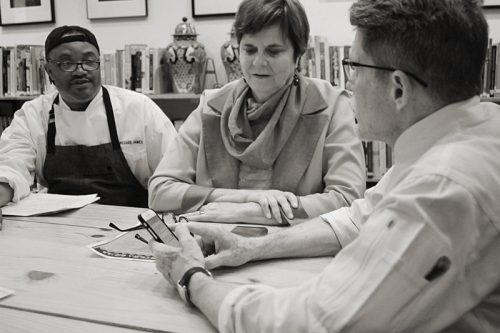
Deann, when you were in Mexico working on a book, what did you see this all leading to?
DEANN: Well, hopefully a book… I don’t know that I thought very much ahead from that, we were just absorbed in the project.
RICK: We did it like graduate school research—we didn’t just go, Oh, that tastes good. We were super rigorous in our studies—
DEANN: We had a big library, books published in Mexico, so I did all this research in the books, and created all these charts, comparing one recipe to how many recipes I could find of it, and how they differed. We catalogued markets, and it was very rigorous. We’d stay somewhere for three, five days, and then we’d move on to another city.
It was hard travel. We just worked a lot.
RICK: And we walked a lot, too, because we would just walk everywhere. Up and down streets, just looking for things, and making notes about, this looks like a very traditional style family restaurant, what do they have on the menu, and we’d write down what was on the menu so we could really understand what people were eating in that town.
And if we found something that we thought was the dish of the town, we always ate it three times by three different cooks, so that we could see the variations in it and all that. Because that’s what you do in anthropology, you don’t take one person’s word on anything. And that’s why Authentic Mexican is written the way that it is.

3. Opening Frontera
RICK: We finished that book, turned in the manuscript—and then we had to figure out what we were going to do. I didn’t know if I could find a way to make a living being a food writer, and what I did know how to do was professionally cook, but I hadn’t been to a school that could teach me how to do the kind of food that I was writing about.
So we opened Frontera in 1987. We spent about a year developing it—Deann was really working, like, temp jobs and all that sort of stuff. We were doing a little bit of consulting work during that time, and we opened in the spring of 1987.
Did anybody know who you were when you opened?
No, nobody did. I had never worked in the restaurant business in Chicago, so I was really learning it from the ground up. So I would ask people, like, who’s a good vegetable purveyor here? And somebody would say oh, you should talk to these people. And I was just asking anybody and everybody, but remember, when we opened up, there were only, what did we say, two or three chef-owned restaurants—
DEANN: You said Jennifer [Newbury of Amerique] was, but I thought she wasn’t.
RICK: She was open, so that was three chef-owned restaurants in Chicago—Yoshi’s, Jackie’s, and one called Amerique, that had opened up in the space where MK is. That was kind of it, so we just asked around to people and said, where should we go, who sells the flatware, and stuff like that.
We really knew nothing when we came in here. I just fell in love with Chicago and said, this is the place where I want to be, because I really loved the fact that we were in the midwest. We’d been living half time in L.A.—and L.A. is super trendy. And so after about three or four years, you kind of had to close your restaurant up and reconcept it. And I didn’t really want to do that.
Remember, I grew up in a restaurant that was open for 37 years. That taught me that longevity’s a good thing. I loved the fact that in Chicago, if you offered good value, and you kind of kept up with the times, but were not super trendy—you could actually have a really long run here.
Which is why we’re talking here now! I’ve got seven years to go before I beat my parents’ record.
DEANN: We decided to settle in Chicago because we knew we needed to be in a major metropolitan area to open our restaurant. Because we needed to live somewhere that people traveled and understood the distinction between the chain version of a restaurant—Mexican, Italian, whatever it is—versus something you might find in that country.
So we needed where people were sophisticated enough, and then my memory is that when we opened this restaurant—well, first we debated putting things like margaritas on the menu. Because they aren’t really Mexican. But then we also knew that we needed money to stay in business. We weren’t quite that naive. But then people criticized us because they weren’t made with sweet and sour mix, they were made with lime juice and sugar. It was at that basic level.
But then there was this whole other thing where people who understood about Mexico, they came out of the woodwork. Not that we were packed, right away, necessarily, but there were people who understood that it was something special.
We debated putting things like margaritas on the menu. Because they aren’t really Mexican. But we also knew that we needed money to stay in business.
RICK: We had a pro forma that was like, how much we thought we could grow the business, and pay off our debts, and stuff like that. And at six weeks, we hit our six month level, and at six months, we were beyond what we thought we could do—
DEANN: And in nine months we paid off all our opening debts.
RICK: We opened it on a shoestring, so we didn’t have huge debts, and we didn’t spend any money, so Deann and I weren’t taking any money out of the restaurant. But we were successful enough to then be free and clear. And that’s how we could open Topolobampo two and half years later.
DEANN: By then we could get a bank loan, because we had proved ourselves.
The Tribune recently reprinted Frontera’s first review, by Paul Camp, which came when you had just been open a month. I was surprised they got to you that quickly.
RICK: Four weeks! I was shaking in my boots.
I suppose that was because of the book—I can’t imagine they were paying that much attention to the Mexican food at, say, Su Casa.
It was really lucky that our book came out the same day that we opened. We couldn’t do any publicity on it—I remember that I had an interview with JeanMarie Brownson, who now works with us and has for twenty years, from the Tribune about how we wrote it and that sort of stuff. And that review of the book really helped to launch the restaurant, too. Because the food was really different from what you would find in most Mexican restaurants in this town. And we wanted to do the real food of Mexico, and just having the Tribune review the book was super cool, because they said that “these people have done their research. They spent all these years doing this research, so you can trust them.”
Now, we could have done the research and still not been good cooks. But we, thankfully, were good cooks.
DEANN: We were also super-thoughtful about how we created the menu. Evidenced by the fact that the menu has still got core dishes on it.
RICK: It was funny that on the 30th anniversary, Deann and I sat down in the dining room to eat dinner, and I said to Deann, I only want to eat the dishes that have been on the menu for thirty years. And we were like, well, can we do that—of course we can do that.
We didn’t even get to them all, we couldn’t finish them all, we didn’t even order one of them, right?
DEANN: A couple. The queso fundido… and we didn’t eat any of the tacos.
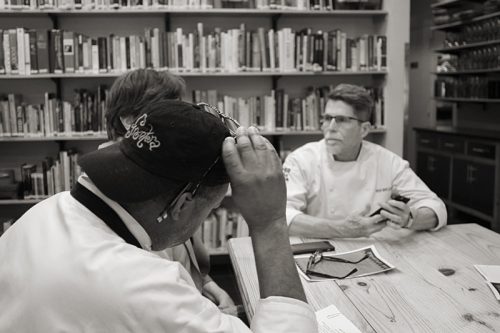
RICK: Okay. And I have gorgeous pictures of them, because I wanted to see, if I took pictures of them, do they still hold up today, or would they look like they were slightly dated. And some of them are plated exactly like they were on the first day we opened, and they just look great. And there’s nothing I would change about it—you know me, I change the menu, we all change the menu all the time. But I always say, if a dish from our original menu feels dated, get rid of it. Get rid of it. And these things persist.
DEANN: We thought really carefully when we opened about how we would bridge a gap and gain people’s trust. And Rick, being a live fire guy, said I want the grill to be the touchstone, because everybody loves grilled food. So that’ll make everything taste good. And this whole thing of tacos, because we weren’t serving ground beef in U-shaped shells, everything had to be super-delicious grilled meats. And the tortillas, of course, were the bedrock of everything, so they had to be handmade from fresh masa.
So we were really calculated in that. And for a long time—maybe not a long time, but for half a year—those tacos were a big part of our sales. And then we started putting on some specials, that were the regional specialties, and then over the period of a couple of years we saw the menu make a shift as people gained a trust in what we were doing.
But we thought about those dishes—you thought about those dishes—for a long time. What will just be so delicious that people can’t not come back for it? What will make them feel comfortable even though this food is so different? How can we say, this is Mexican, but it’s not what you’re expecting, but it’s going to be wonderful.
And then, even in the decor, we didn’t have anything that marked of stereotypical Mexico. Like mariachis. Even though mariachis are wonderful, we didn’t do anything with that.
RICK: Right now you can occasionally hear mariachi music, but there was a moratorium on any mariachi music in this restaurant for twenty years. I wouldn’t allow any of it to be played, and nothing on the walls that would smack of stuff that you would expect to see in a stereotypical Mexican restaurant.
No paintings of guys taking siesta?
None of that!
DEANN: No sarapes…
RICK: None of that stuff.
DEANN: We wanted people to walk in and say, this isn’t what I was expecting Mexican to look like, and then taste it and go, this isn’t what I was expecting, but be open to it.

4. The Language of the Kitchen
So there’s an early menu from Frontera that turned up on the internet—the week of April 18, 1989—
RICK: Two year anniversary?
Yeah, “Greatest Hits of Frontera Grill,” from two whole years ago.
Almost every year, we’ve done a greatest hits. But it usually is the greatest hits of that year, what the guests have responded to the most that year. Now, we let the service staff pick it, and we serve that only on New Year’s Eve.
What I found looking at the list is that while I can imagine any of these being plausible items at Frontera now, what I can’t imagine is it being so meat-focused. It reads like a list of meats, first.
Really. Hmm.
I feel like now, many of the same items would lead off with what form the masa or the mole took, and the meat would be secondary. Was that just, Chicago in the 1980s, land of steak, so even Mexican food was kind of refracted through, what big protein do I want first?
Well, we definitely eat lighter than we used to. Remember, that’s 28 years ago. I just told the guys at our last creativity meeting, I want another all-vegetable starter dish, and it can be hot.
We are more vegetable focused than we used to be, but I will always say, we are not trying to do museum-quality Mexican food. Because first of all, it is absolutely impossible to do. We would have to fly all of the food in from Mexico, we’d have to be cooking with Mexican water, and we’d have to fill this place with only people from Mexico, and that would be the museum-quality Mexico experience.
What we say is, we are deeply influenced by the spirit of the Mexican kitchen, but we’re expressed here in Chicago with Chicago ingredients, playing to an audience of Chicagoans.
DEANN: Spirit and technique, I’d say. Technique is critical.
RICK: Sometimes I say it that we’re deeply rooted in the traditions of the Mexican kitchen. So that would be ingredients and technique, and flavor balance, which is the most important thing in Mexican cuisine. You even find it on 18th street sometimes, that the flavor balance at some of those places that you think are authentic is really American, and you wouldn’t taste some of that stuff in Mexico.
DEANN: We’ve been thinking about that a lot lately, because—like I love Japanese food, and I love Japan. And we went to Japan for our vacation in January, and as we were eating there, I kept thinking of where I like to eat Japanese here, and they’re like different things.
RICK: It’s like different cuisines.
DEANN: It is different cuisines.
RICK: But it’s the same basic stuff, so you go to some place like Momotaro, which is deeply rooted in the cuisine of Japan… but it really tastes like you’re in Chicago.
DEANN: And personally, I like Chicago Japanese…
A lot of the kitchens in the United States just speak English, with Chinese words or Spanish words or Italian words thrown in. Our kitchen speaks Spanish, with American words thrown in.
RICK: No, I like them both. And sometimes, the food in Japan is just flat weird.
But what we have always said that what we do is to express this deep love for and understanding of—
DEANN: Understanding of, is critical. Because there’s a new Chinese restaurant we went to—I spent a year living in China. And I thought, this food doesn’t even begin to taste Chinese to me. Because all the balances were off. They weren’t understood. It was tasty food—
RICK: The food was all good, but it wasn’t Chinese.
DEANN: It’s like learning a language. That was speaking with a heavy, heavy American accent, if you will.
So how would you describe what language your kitchens speak?
RICK: Our kitchen speaks Spanish, with American words thrown in. A lot of the kitchens in the United States just speak English, with Chinese words or Spanish words or Italian words thrown in. But we really try to speak Spanish, Mexican Spanish in our kitchen. Sort of metaphorically as well as literally what we speak.
RICHARD JAMES: I think we push really hard to maintain our Mexican culture here. Particularly through the language. And I find myself correcting some of the younger generation, speaking their Spanglish.
RICK: Because they’re all Mexican-Americans, raised here. And they really speak Spanglish a lot. There’s radio stations that speak Spanglish here. And it’s really funny because, when you get a lot of these young, immigrant kids, that came here at 17, say. So they’ve finished as much schooling as they’re gonna get. They come here because there’s no place for them to work in Mexico. They get jobs, but they’ve never learned the vocabulary for much beyond their home and their school. They would come to me, because I have a degree in Spanish literature, and say, what’s the right way to say this, what’s the proper way to say this in Spanish? Or what’s the real word for this?
We have a Mexican-American kid who’s one of our sous chefs, and he speaks really good Spanish. And he grew up going back and forth to Mexico, because in the summers, he would spend it with his grandparents in Veracruz. And when we go down to Mexico for events, he hates to go down there because, he says, “They’re all going to call me a pocho. Because I speak differently from them.”
And he’s probably the most rooted of all of our chefs in Mexico, and still they make fun of him. I think he speaks perfect Spanish, but he says no, no, no, because of some of the expressions I use, they say you’re not one of us, you’re not Mexican.
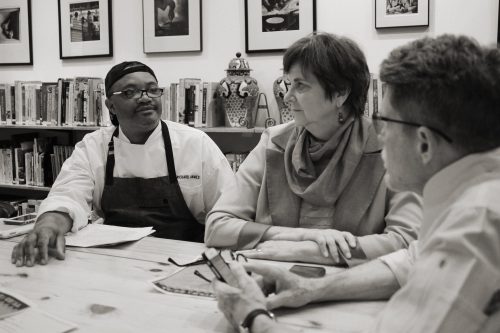
Richard, did you speak Spanish when you started here?
RICHARD: Not a lot. I’ve been working in kitchens for a very long time, so I’d been learning kitchen Spanish at my previous job, and then, when I started working here, I decided that I wasn’t going to be teased behind my—well, in front of my face, in Spanish. So I worked really hard, I spent two weeks walking around rolling my R’s, so I could make sure I made my R’s correctly.
And then I fell in love with my wife, who’s Mexican.
RICK: He had to go and ask for the young lady’s hand, to her mother, in Spanish, because her mother doesn’t speak any English.
RICHARD: And I would have to watch television, with my now-wife, in Spanish, because she didn’t speak a lot of English, so that helped me to grasp Mexican Spanish.
You learned Spanish from Sábado Gigante?
Sábado Gigante, El Gordo y La Flaca, watching novelas…
RICK: El Chavo del Ocho, did you watch that?
RICHARD: El Chavo del Ocho, oh yeah.
RICK: That’s really funny, because I was talking to a guy from Mexico that I thought just spoke the most beautiful English, and I said, where did you learn it? And he said, Beatles songs. When I lived in Mexico, I used to watch all the telenovelas, because they speak REALLY! DRAMATICALLY! and slow. They enunciate, so you can really understand what they’re saying.
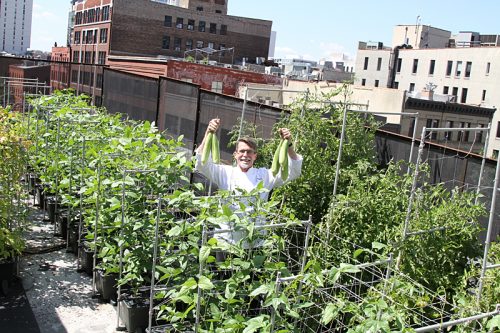
River North is different now
5. The World Frontera Made
You opened in River North, hot restaurant neighborhood River North, before it was even River North—what did they call it then?
DEANN: It was called River North.
RICK: No no no, River North came five years into it.
DEANN: Really?
RICK: At least five years into it. Because that was created entirely by Al Friedman.
RICHARD: Yeah, I didn’t know this neighborhood as River North when I was growing up.
I know a little further north was known as the Tenderloin, way back when.
RICK: This was too. And it was known as the district of the Clark Street flophouses.
And you still have The Baton! Next to a Starbucks, now.
DEANN: They predated us. They were actually the only sort of—well, Gordon restaurant was here before us.
RICK: And one of the reasons we loved this space was that we could tell people that we were kitty-cornered from Gordon.
DEANN: You know, he [Gordon Sinclair] was avant-garde.
RICK: He was avant-garde, and he put his restaurant in a very sleazy area, because he knew he had all destination diners. They were going to get out of their taxis or limos or whatever, and go right in.
DEANN: But they also found it fun—it was sort of like slumming.
RICK: And his first Gordon restaurant was in an old adult bookstore. Then they moved down to the corner space, where NAHA is, after about five or seven years.
That makes more sense, then, because I always did wonder why you did that—you were introducing an new cuisine and, basically, making people come to a new neighborhood at the same time.
RICK: Well, the reason why we were here was because we could afford it.
DEANN: And it was an artistic area already.
RICK: It was starting to turn a little artistic because it was close enough to the [Merchandise] Mart—in fact, where Frontera is was this really high-end Asian antiques store. When they moved in ’87, they moved to the Mart. So there was enough of that stuff going around.
Do you have a sense of any particular time that Frontera underwent a big change after it opened? Like you went somewhere and came back thinking, let’s add this to the menu.
One thing is that we built a place on change. So the menu’s changing constantly. The first year, the first two years that we were open, we changed our menu every week. And when I say “changed our menu,” we changed 75% of our menu every week. And that was really crazy.
Then when we opened Topolo, we changed it every two weeks, but we were still changing one menu every week. And then we realized that we were just throwin’ menus together. And we really wanted to think them through. I don’t know how long ago it was, but we went to a monthly menu. Because we couldn’t keep up with it, it was just too much R&D work for us to do.
There’s people who say Mexican food is cheap food. And you’re supposed to use really crappy ingredients and never pay the staff, right? That’s what you’re looking for?
How did opening Topolobampo change Frontera?
It was very interesting, I knew what I wanted Topolobampo to be but there was no way I could achieve it then. It’s taken till now, 27 years [laughs].
Every time that we would reconcept Topolo and really think what we wanted it to be, but in the beginning, we just needed to fill it, so it was just like a fancier version of Frontera.
DEANN: And it took reservations. That was a big deal.
RICK: Right. But the prices on the menu were just not that different. It was ten bucks more for an entree, that kind of thing. It wasn’t a huge jump, so we could sell unreserved tables just off the name Frontera. “We have a two hour wait at Frontera, but in 20 minutes we’re going to have a table at Topolo, you want to take it?”—that’s how we got people going over to Topolo.
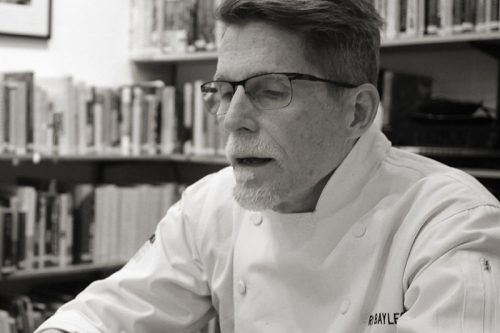
It’s a quieter atmosphere in Topolo, so people would taste the food differently. I remember right after we started, one night we had a problem with the sauce and I said, let’s just grab the sauce from Frontera that’s the most like this one, and we’ll just put it on the menu. So we served it all night long, and a table called me out and said, “Oh, we really liked our meal. And we eat at Frontera all the time, and I just want to tell you, there is so much more nuance and sophistication to the sauces in this dining room than there is at Frontera.” So what did you have? Well, what she had of course was the sauce that we pulled off the Frontera line.
It’s just a quieter atmosphere, people could pay more attention to it. They could perceive nuances that were in that sauce, that you could have gotten at Frontera.
Did it take a while for people to take it seriously enough to feel it was worth spending that kind of money on Mexican food?
No, we were busy from the very beginning.
DEANN: Some people complained. But it was very few. I can see their faces, the people who complained in those early years. They were grumpy people to begin with.
RICK: They were grumpy people. And there’s also those people who say Mexican food is cheap food. And that the prices we charge at Frontera are just horrible. Because, if it’s Mexican food, it’s supposed to be cheap. And I said, oh, yeah, and you’re supposed to use really crappy ingredients and never pay the staff, right? So that’s what you’re looking for? Places where people are treated really poorly and you get really crappy ingredients. That’s what you really want?
Well, they don’t think that far ahead. You get what you pay for, basically.
DEANN: But we ran up against a lot of sour grapes.
RICK: Just pick out today’s Yelp reviews of Frontera right now—”It’s much better at the little place on the corner by my house, for $7.99 I can get this—” Yes, well, none of those family members working there are getting paid, right? That’s not happening, and let’s look at the quality of the ingredients that they’re working with, all that stuff.
DEANN: Plus, it’s sociological. But it’s changing. Although now, maybe it’s regressing.
RICK: It bugs me—and then I let go, and I’m on to doing what I like to do.
I see this a lot with Asian food too—there’s the real dichotomy between the “authentic” places, which are perceived as being funky but cheap, and the higher end Asian places, which often dumb it down, but they do have higher quality proteins—like P.F. Chang’s has a higher grade of chicken—
But that’s all they have. We have never wanted to touch that, we’ve never liked saying oh, Topolobampo’s more sophisticated. Right now, we have blazing hot dishes in Topolo, we have really gutsy things on the menu in Topolo. It’s because that represents the cuisine. We are trying our best to channel the real cuisine of Mexico. Because now Mexico is just filled with young chef-owned restaurants that are doing amazing things. For a long time, we were kind of it, and we’re not even in Mexico. And then, about fifteen years ago, things started to change a little bit there, as some of those restaurants started to open, but it’s only been in the last seven or eight years.
There’s a really interesting restaurant in Oaxaca called Origen—Rodolfo Castellano. He worked for a long time in San Francisco, under Traci Des Jardins there, and then when he came back to Mexico he wanted to do that food, so he was doing all locally sourced stuff but it had a kind of international flair. But any time he had a dish that had Oaxacan roots, that’s all the clientele wanted.
And finally, after all these years, he has evolved his menu to do modern Oaxacan food with locally sourced ingredients. He wasn’t doing particularly well, and then he won the first Top Chef Mexico. He’s a really talented cook, and now he’s got a menu that is very beautiful, contemporary Oaxacan food, and I’m really happy for him.
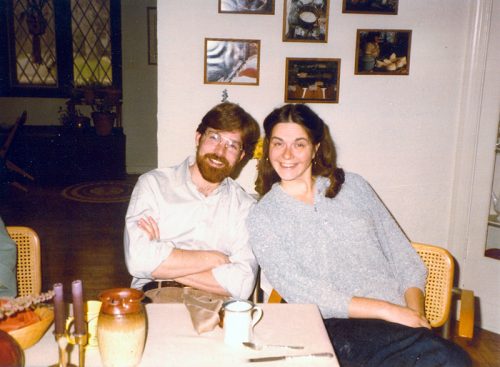
6. Life on the Frontera
At the same time you’ve been running these restaurants and opening others, you’ve had TV shows, you’ve worked on books—how do you make the restaurant work without you, Rick, or the two of you, present? You must have had to figure out early on how to do that.
RICK: My philosophy about the restaurant is that I’m a very hands-on type person. But I learned very quickly that—you know, I worked the line at Frontera until we opened Topolo. Then I moved over and worked the line at Topolo for two years. And then it dawned on me at one point that, man, I wasn’t hardly seein’ anything. Because I was so buried in my station on the line, and I was not seeing what was going on in Frontera at all, because I was so focused on Topolo. And then I just thought, for the health of this restaurant, I need to step aside.
We change constantly, we work with really great ingredients, I’ve always been super dedicated to developing local agriculture so we’ve always had great relationships with farmers. It’s the kind of place that you feel like you’re actually doing something for your community besides making great food to eat. So that, plus the fact that it’s a five-day work week, we have been very lucky to have a lot of long-term staff. And as people would take on more and more responsibilities, I was willing to step aside and say, now it’s yours. This is your responsibility. And we have been able to grow.
At the beginning, every three years we had a new project. We opened Topolo, and then we had a baby. That was our project that year. That really changed a lot of stuff for us! And then we opened this place around the corner called Zinfandel, but the partnership was awkward and we just stepped back—we were both trying to do something different in the space.
I’m a person that likes to tackle new things all the time, and so after something gets settled, I want it to have a life of its own. I don’t want to micromanage. I want to be involved in it every day, but I don’t necessarily want to be the driving force behind it. I can be the spirit behind it, but I don’t want to be doing the nuts and bolts.
So that’s why, as we’ve grown, we’ve always found people who wanted to take over these things, Richard’s a great example of that, he’s been with Frontera for a really long time. The guy who’s our culinary director now, Andres Padilla, he’s been with us for a very long time, and just lives and breathes the philosophy of what we do. And the philosophy of what we do is change, and just deepening our knowledge constantly. And reading books, and traveling to Mexico—we take all of our management staff every year, and in many cases more than once a year.
No dish in the restaurant is ever finished, no project is ever finished, everything is looked at freshly, all the time.
So we’re all growing all the time. We really push all of our staff to grow all the time. And I think that’s both what has allowed me to tackle new projects, but it’s also allowed me to give over the reins.
DEANN: Plus another role became clear, mostly for you—which was maintaining a vibrant national image, to keep the restaurants full.
RICK: That, plus in that image was all this knowledge that I was spreading out there.
DEANN: So actually the TV shows, in a lot of ways, are our education, our continuing education. We don’t make any money from it, but we get to go to Mexico, we get to research it for one area intensely for ten days, then we get to be back there again filming it. So that’s feeding us at the same time it’s pushing the image forward. Same with the books—it fed the books, too. All these things we do dovetail, and the things we do that are not directly related to the restaurant, we can do them from here. This is our office here, we don’t go somewhere else away from Frontera to do these things. Unless we’re traveling for filming—but that’s only a tiny part of filming a TV show.
So as you said, Topolobampo followed Frontera less than three years later. Was that actually the plan all along? Did you have your plans for the future all mapped out from early on?
DEANN: I think that neither of us have ever been the type to make a five-year plan. Or to make a strategic plan and then work it, as they say—
RICK: It’s fun to make ’em, but that’s not what we live—
DEANN: I think we are both very thoughtful while we’re going along, and then ideas start bubbling, well maybe we should do this, and that turns into the next step within a few years. I think that’s worked to our advantage because, rather than coming at it from, well we’ve got to get there, we think, well this is going well, what else could we do.
RICK: As Richard will tell you, no dish in the restaurant is ever finished, no project is ever finished, everything is looked at freshly, all the time. I call our approach the next right step—
DEANN: I hadn’t heard that. You could write a book!
RICK: Gee, I could be on the New York Times bestseller list… We would always look and say, what’s the next right step for us, what makes sense for us? Because we’re always thinking about these things, and staff is always thinking about these things, somebody will throw something out, and we do all of our research and figure out if it’s the right thing or not, and if it is, then we take that step.
And you know we didn’t open another restaurant—we did the stuff at the airport, and that took a lot of energy but it didn’t take it from this restaurant’s staff, because those are licensed things. But from the time we opened Topolo till the time we opened Xoco was a really long time. But we were working on other things. We were really working on Frontera and Topolo all of that time, and Topolo took a lot of energy to keep taking it to the next step and the next step. I always say that, okay, now this is where I want Topolo to be. Until tomorrow, when I think of something else.
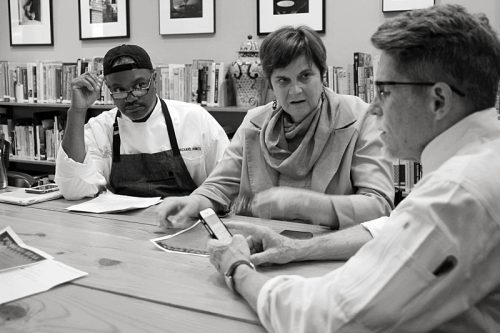
But we just came back and reevaluated all of Frontera, just last year. A whole new menu format, and that sort of stuff. We don’t leave anything to…
DEANN: And I think we trust to intuition a lot.
RICK: Yeah, a lot.
DEANN: Like when we started with one storefront, and then we took over the storefront to the north, and then we were just those two storefronts, and people kept saying, aren’t you going to take over the one that way? Because we needed a bar so desperately, and I kept saying no no no, and then all of a sudden one day—
RICK: It just seemed right.
DEANN: And I said now’s the time. It was pure intuition. I probably waited really long—
RICK: No, I think it was the right moment.
RICHARD: It was the time when Frontera couldn’t contain the number of people that wanted to be here and eat.
RICK: It was getting to be negative—
DEANN: The energy was getting to be negative. We needed to add some more seats.
But there’s a readiness principle—you can’t teach a kid to count until they’re ready to count. Raising a child, I didn’t believe that for a long time. I believe it so much now. But I don’t think it’s only about kids—I think within ourselves, within myself, if I’m open and wanting to grow, and not just life’s cruising along, I will know when there’s moments to push forward.
And now I know it’s not the moment to push forward any more. We have plenty of restaurants—
RICK: We have our hands full.
DEANN: We gotta get everything comfortable, and stabilized, and smooth.
Michael Gebert often needs an emergency taco as editor of Fooditor.
Latest
Join the Discussion
After you comment, click Post. If you're not already logged in you will be asked to log in or register with Disqus.





